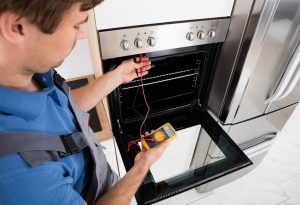Updated on March 12, 2023
Why Oven Turns Off By Itself
There has been no change in the fact that stoves have been there for hundreds of years: they’re quite temperamental! With this instruction, you’ll never be left wondering why your oven shuts off on its own for no apparent reason again. There are a number of prevalent causes for this. Do not use the oven if you notice any of the following difficulties.
Suddenly, your attention is required when an oven shuts off. A wide variety of factors might cause them to go down. However, all of them demand quick action. Issues with temperatures or heating components are among the most common causes, as are electrical or control board malfunctions.

Oven Turns Off By Itself – Troubleshoot and Diagnosis
These are some of the more typical reasons of an oven shutting off on its own, but not all are.
Blocked Ventilation Or Faulty Cooling Fan
Modern ovens are built with food and human safety in mind. By utilizing a strong cooling fan to pull in ambient air, improved ventilation systems take cold air into the oven and safely expel hot air out the rear. Your favorite dish won’t dry out or make you wait for it to cool down because of the very effective ventilation.
Many individuals get alarmed when they learn that their oven vents need to be cleaned. Because they are unsure of where to begin or how to proceed, they put off completing the chore and let the mess to worsen. However, one topic is never brought up. It’s the kitchen’s most dreaded task, but it’s also the most critical: the oven. It is important to clean your oven on a regular basis if you use it often (cooking several times a week).
In and out of your oven, there’s always a lot of air. All of that air has to come from someplace, and it does come from somewhere. There is a large amount of air that travels through the ventilation holes in your oven’s metal shell; these vents may get clogged with dust and other debris, making it more difficult to operate the device.
Your oven generates a great deal of heat to keep itself cool while in operation. The temperature may increase if food gets in the way of the vent, causing it to become hotter. As a result, the oven will shut itself off. This is a precautionary measure to keep you and your house safe from harm should a vent get clogged.
A technical problem, but you may be able to fix it on your own.. It’s possible that the cooling fan in your oven is malfunctioning if it keeps shutting off by itself. Plugging in the oven and letting it on for around 10 minutes is a good way to see whether it works. There is no need to be concerned if the fan is blowing a lot of hot air out of the room.
Remove any debris from the vents and wipe them down with a soft cloth or a vacuum cleaner if necessary. A good idea is to make sure the cooling fan is working correctly and to clear it off any dust that has collected on it.
Before you begin cleaning your oven, unplug it. Sweep out the vents and remove all the gunk with a vacuum. Wipe the vents clean with a moist cloth after each usage to ensure smooth circulation.
Faulty Temperature Sensor/Thermistor
Thermistors, or oven temperature sensors, are very small, thin metal bits. When the oven is turned on, the sensor inside becomes hot. A temperature readout may be obtained by measuring the thermistor’s resistance, which changes when this occurs.
It is there to ensure that the oven always reaches and maintains the temperature you have chosen. Because it eliminates the need to constantly monitor the progress of a pizza or to keep the oven running to maintain the temperature you set, it enables me to work more quickly and effectively than any other alternative.
The oven’s thermistor makes it simpler to regulate the temperature. The thermistor regulates the power to the heating elements based on the oven’s current temperature, ensuring that your food is cooked to perfection every time.
Ovens that turn off before they’ve started cooking are almost often the result of a bad thermistor. When this occurs, you’ll want to double-check your thermostat and other components, but most importantly, your thermistor.
A defective thermistor may be dangerous since it lies at the very heart of your oven. As a result, the oven’s brain malfunctions, causing it to prematurely shut down due to overheating. As a result, your time and money will be wasted on meals that you didn’t get to eat.
Replacement parts and a tiny Phillips head screwdriver are all you need to fix a damaged temperature sensor. As a first step, unscrew all screws retaining the old sensor. Then, unscrew the capillary tube that connects to it and take it out of the oven’s rear door. Remove the sensor’s remaining screws and disconnect the sensor’s electrical connections from the rear end. Simply reverse these instructions to swap out the old one.
There are several advantages to using your oven’s user manual to diagnose problems, yet few people do so. However, avoiding the need to troubleshoot is possible if you follow the procedures we’ve outlined here. Make sure the gas supply is turned off and the supply pipes are disconnected before removing any paneling or changing any elements of a gas oven.

